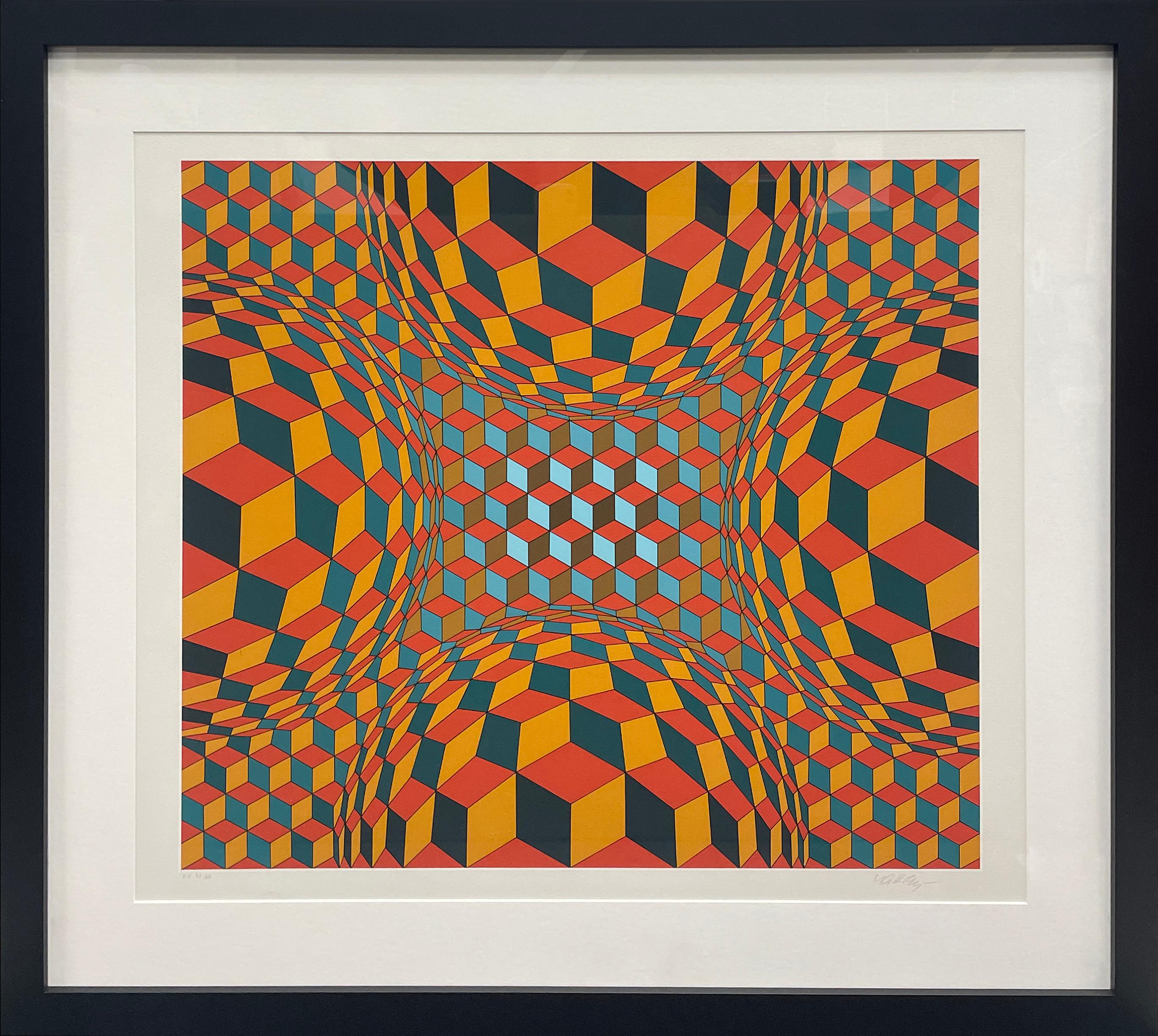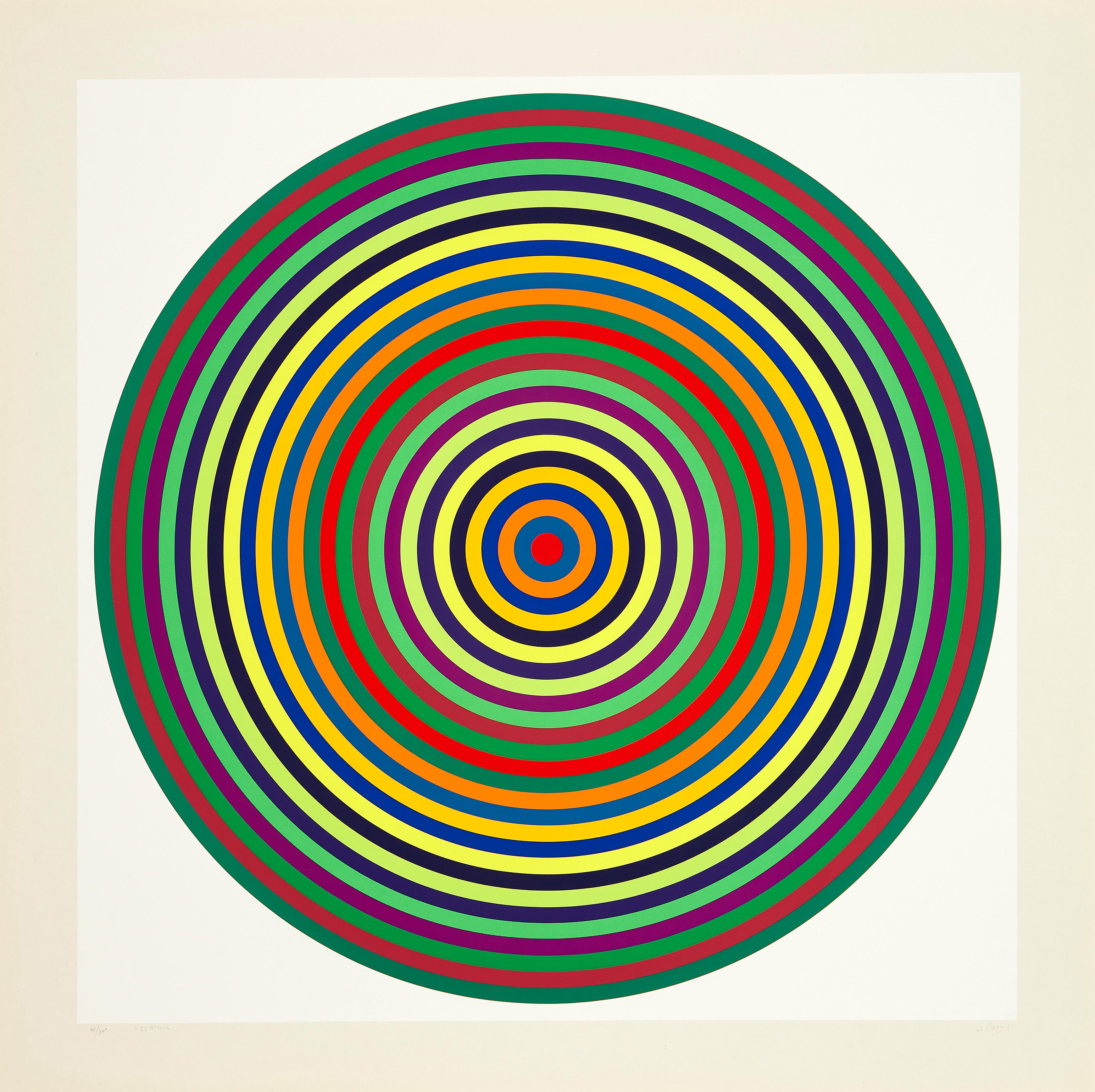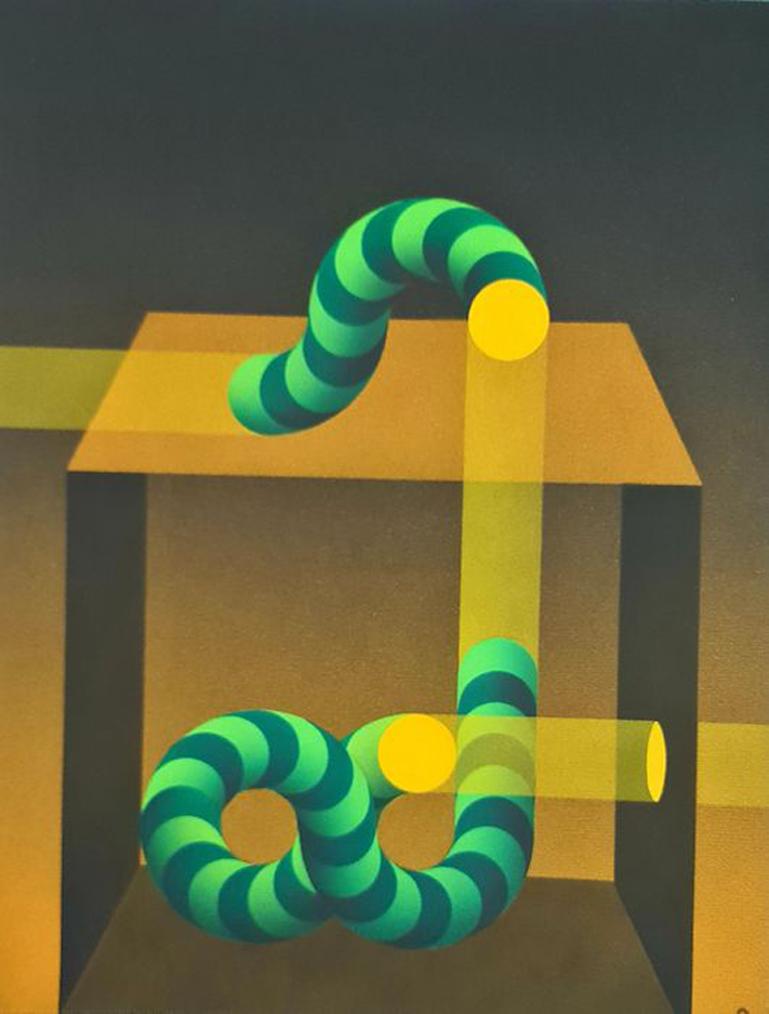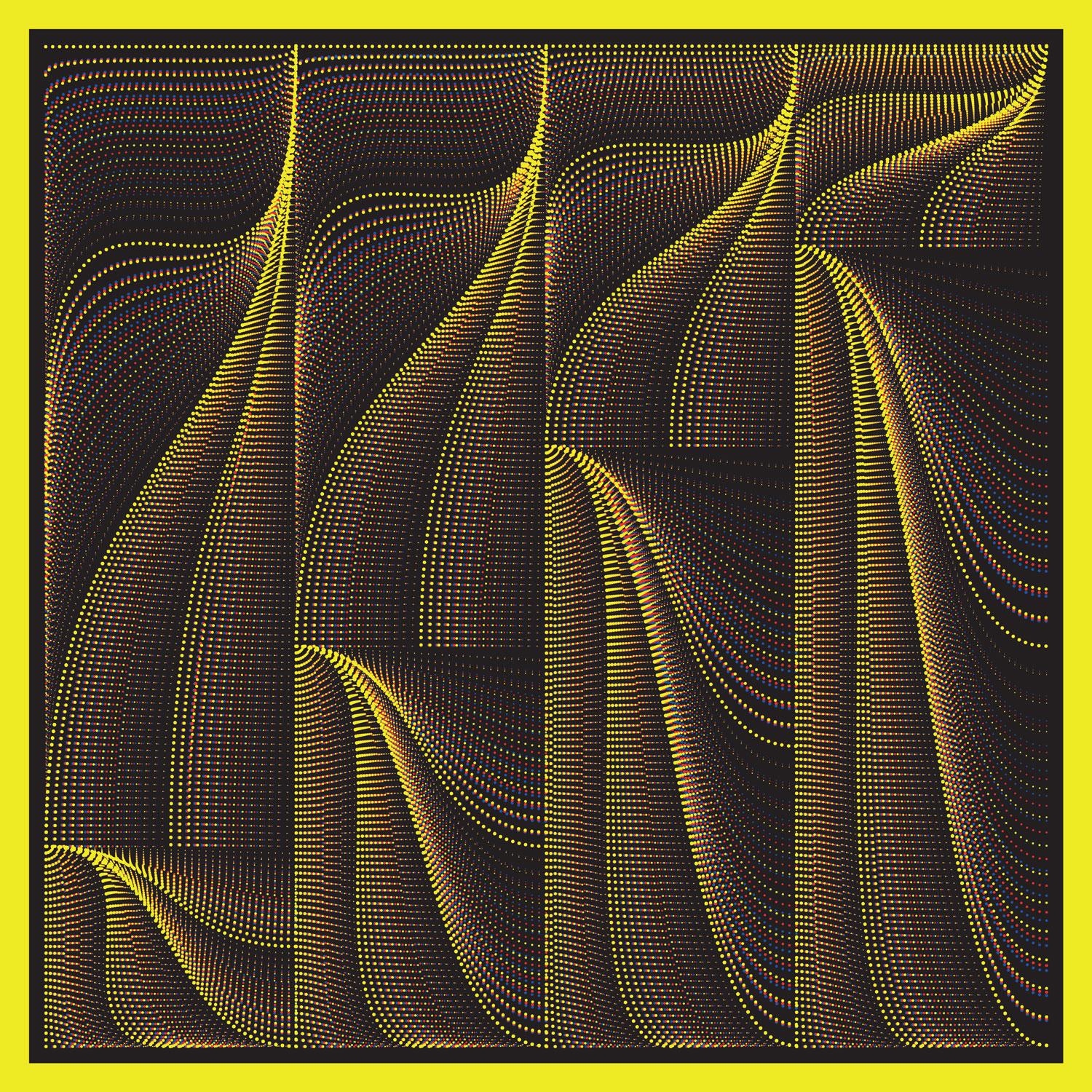Items Similar to Moon Rays
Want more images or videos?
Request additional images or videos from the seller
1 of 10
Ray H. FrenchMoon Rays1967
1967
About the Item
Moon Rays
Graphic Construction (three sheets layered in a shadow box presentation), 1967
Signed lower right. Editioned lower left. (see photos)
Edition: 60 from the second printing c. 1990 (see photo)
Presented in a black wooden frame with a three level archival presentation with OP3 Acrylic
Frame size: 31 1/4 x 23 1/4 inches
In the 1960s, Ray also started to focus on blind embossing, which he had first experimented with at the University of Iowa. He was extremely prolific and successful with this medium, selling hundreds of prints in small editions of 10 through the Associated American Artist Gallery in New York. In 1966, Ray built upon his mastery of embossing and began developing a shadow box presentation called a graphic construction that combined color, blind embossing, and multi-layered cutouts to revel embossed intaglio compositions. Noted curator William Lieberman purchased Ray’s masterpiece graphic construction, Moon Rays, on the behalf of MOMA New York and another impression was gifted to the University of Iowa Museum of Art by Alan and Ann January in 2004.
Note: An impression of this image was purchased by William Lieberman for the collection of the Museum of Modern Art, New York. (See MOMA paperwork in photos)
Ray H. French: The Evolution of an Artistic Innovator
Printmaker, painter, and sculptor Ray H. French was born in Terre Haute, Indiana on May 16, 1919. Terre Haute was a cultural wasteland before the opening of the Sheldon Swope Art Museum in 1942. Thus, with a father as a coal miner and carpenter, art remained a luxury for Ray. Nevertheless, local art teachers Mabel Mikel Williams and Nola E. Williams helped to foster his creativity and unshakable drive to create things of beauty.
After high school, Ray attended the John Herron School of Art in Indianapolis. His studies there were interrupted by the outbreak of World War II, during which he developed surveillance photographs for the Army Air Force. After the war, Ray transferred to the University of Iowa on the G.I. Bill, where he received both his BFA and MFA degrees. The University of Iowa during the 1940s was a cultural mecca with many major art historians and artists. While in Iowa, Ray played an important role in this culture by becoming a founding member of the Iowa Print Group under Mauricio Lasansky.
Following his graduation in 1948, Ray experienced firsthand the rapid rise in creative printmaking in America. By 1949, he had exhibited at The Brooklyn Museum, the Walker Art Center, and MOMA New York. Ray’s early style of printmaking is characterized by pure line engraving on copper plates, a technique suited perfectly to his study of the beauty of animals. This charming and whimsical subject ran counter to the concurrent trends of Lasansky’s horrors of war and Hayter’s non-objectivity, but was equally effective in capturing the public’s attention. Walruses was purchased by the Victoria and Albert Museum, exhibited at MOMA New York and received the Arthur D. Allen Memorial Purchase Prize for its “skillful and economic use of line.” Shortly thereafter, Ray’s treatment of animals developed further into larger format mixed intaglio prints utilizing hard ground, soft ground, etching, and engraving, as exemplified in The Swan.
By the late 1950s, Ray’s style evolved into organic non-objectivity, in which he incorporated personal autobiographical vignettes and symbolism. His work during this time was further characterized by a departure from the traditional squared compositional format to his cutting and rounding of the plate to accentuate organic shapes. Ray’s 1959 Enchantment remains particularly illustrative of his use of etching and soft ground intaglio. Enchantment was successfully exhibited at the Brooklyn Museum of Art for the 12th National Print Exhibition of The American Federation of the Arts and received the Pennell Purchase Prize from the Library of Congress in 1960.
In the 1960s, Ray also started to focus on blind embossing, which he had first experimented with at the University of Iowa. He was extremely prolific and successful with this medium, selling hundreds of prints in small editions of 10 through the Associated American Artist Gallery in New York. In 1966, Ray built upon his mastery of embossing and began developing a shadow box presentation called a graphic construction that combined color, blind embossing, and multi-layered cutouts to revel intaglio compositions. Noted curator William Lieberman purchased Ray’s masterpiece graphic construction, Moon Rays, on the behalf of MOMA New York and another impression was gifted to the University of Iowa Museum of Art by Alan and Ann January in 2004.
Throughout his artistic career, Ray was also a professor and administrator at DePauw University, which occupied much of his time. Outside of his creative expression, Ray was most proud of his teaching and influencing students to find beauty in their daily lives. Specifically, he was a particularly fervent advocate of printmaking and joined the ranks of many of Lasansky’s students who went on to establish printmaking programs and departments and to further lift the stature of intaglio printmaking. During Ray’s time at DePauw, he received grants to travel around Europe. His yearlong stay in Florence led to a series of etchings, drypoints, and woodcuts of Italian and Etruscan subjects and provided inspiration for many years.
In 1984, Ray retired from his university service to work in a private studio behind his home on DePauw’s campus. After several life threatening illnesses, Ray decided to return to his early creative style of realist depictions of nature and landscape. Eventually, Ray’s health deteriorated further with the onset of macular degeneration. Legally blind, he continued to create art until shortly before his death in 2000 at the age of 80. “Sometimes when I look at a work I create, I am amazed at what inspired it. I ask myself, how on earth did I create this?” said Ray once. Ultimately, this quest to find beauty and create inspiring works of art provided the greatest source of Ray’s happiness and fulfillment, evidenced by the breadth and quality of his artistic legacy.
- Creator:Ray H. French (1919-2000, American)
- Creation Year:1967
- Dimensions:Height: 30 in (76.2 cm)Width: 22.5 in (57.15 cm)
- Movement & Style:
- Period:
- Condition:
- Gallery Location:Fairlawn, OH
- Reference Number:
About the Seller
5.0
Recognized Seller
These prestigious sellers are industry leaders and represent the highest echelon for item quality and design.
Platinum Seller
These expertly vetted sellers are 1stDibs' most experienced sellers and are rated highest by our customers.
Established in 1978
1stDibs seller since 2013
711 sales on 1stDibs
Typical response time: 1 hour
Associations
International Fine Print Dealers Association
- ShippingRetrieving quote...Ships From: Fairlawn, OH
- Return PolicyA return for this item may be initiated within 10 days of delivery.
More From This SellerView All
- Red to Green PortalBy Richard AnuszkiewiczLocated in Fairlawn, OHRed to Green Portal Aquatint, 1979 Signed and dated in pencil lower right (see photo) Edition: 95 (84/95), see photo Provenance: U.S. Representative James A. Leach Condition: Excelle...Category
1970s Op Art Abstract Prints
MaterialsAquatint
- Three to CompareBy Julian StanczakLocated in Fairlawn, OHThree to Compare From: Twelve Progressions Signed and numbered in pencil Commissioned by Martha Jackson Graphics Printer: Domberger, Stuttgart, Germany Their drystamp lower right cor...Category
1970s Op Art Abstract Prints
MaterialsScreen
- TutankhamonBy Roy AhlgrenLocated in Fairlawn, OHPencil signed, dated, titled and numbered. Image 26" x 18"Category
1980s Op Art Abstract Prints
- SanctuaryBy Roy AhlgrenLocated in Fairlawn, OHSigned, dated, titled and numbered in pencil Edition: 150 (80/150) 15 color silk screen 12" round Provenance: Estate of the Artist By decentCategory
1980s Op Art Abstract Prints
MaterialsScreen
- Centered RingsBy Julian StanczakLocated in Fairlawn, OHCentered Rings Screen print, 1971 Signed and numbered in pencil From: Twelve Progressions Commissioned by Martha Jackson Graphics Printer: Domberger, Stuttgart, Germany Their drystam...Category
1970s Op Art Abstract Prints
MaterialsScreen
- Let It Be OrangeBy Julian StanczakLocated in Fairlawn, OHSigned in pencil lower right Published by Eugene Schuster, London Art Printer: Vistec, Rochester, New York Regular edition unrealized per Stanczak web site This annotated "H.C." ...Category
1880s Op Art Abstract Prints
MaterialsScreen
You May Also Like
- "Composition Cinétique"By Victor VasarelyLocated in Hinsdale, ILVictor Vasarely (1906 – 1997) Composition Cinétique Serigraph in colors on wove paper, 1970 29 x...Category
1970s Op Art Abstract Prints
MaterialsScreen
- "Couleur Additive Perseus" by Carlos Cruz-Diez, 21st Century, Optical ArtBy Carlos Cruz-DiezLocated in Köln, DE"Couleur Additive Perseus" has a stunning appearance and an optical effect, which catches the beholder's attention from the very first time. Carlos Cruz-Diez from Venezuela was one o...Category
2010s Op Art Abstract Prints
MaterialsScreen
- Series 23 No. 12-6By Julio Le ParcLocated in Miami, FLJulio Le Parc (b. 1928) "Series 23 No. 12-6" Color serigraph on paper 29 x 29 in (74 x 74 cm). The work is signed by hand and numbered 41/200. With an embossed stamp of the Edition D...Category
1970s Op Art Abstract Prints
MaterialsEngraving
- Genesis Americana #2By Julio Le ParcLocated in Miami, FLJulio Le Parc (1928) "Genesis Americana #2" 1982, Pochoir on Fabriano "Murillo" paper of 360 grams25.6 x 19.7 in (65 x 50 cm). Ed 69/92.Category
1980s Op Art Abstract Prints
MaterialsStencil
- Modulation ESC030 #20/60By Julio Le ParcLocated in LILLE, FRSigned and numbered lithograph by Julio Le Parc. Sold without frame. Ask for more detail if you need a frame. Technic : Pigment print on archival paper 310gr. Format : 40x40 cm (...Category
2010s Op Art Abstract Prints
MaterialsArchival Paper, Archival Pigment
- SLOWAVE (Yellow)Located in LILLE, FRSLOWAVE (Yellow) Signed and numbered screen print by Florian & Michaël Quistrebert. This edition has been done in 2021. Item is new, sold by the publisher. Available without frame....Category
2010s Op Art Abstract Prints
MaterialsPaper, Screen
Recently Viewed
View AllMore Ways To Browse
Vintage Wooden Army Box
Vintage Carpenter Box
Vintage Carpenters Box
D Drouin
Agent X Ice Cream
Arrows Calder
Basquiat Gold Griot
Chess Victor Vasarely
David T. Darling On Sale
Joan Miro Cantic Del Sol
Laura Iniesta
Lp Watches
Marc Chagall La Mariee
Marc Chagall Mein Leben
Marcel Ceuppens
Matsumura Plate
Mein Leben Chagall
Melissa Santamaria





